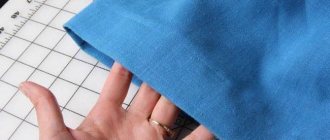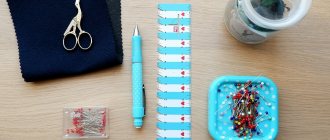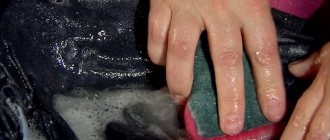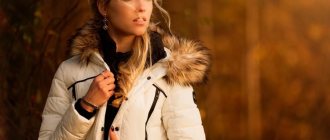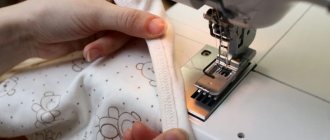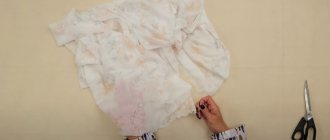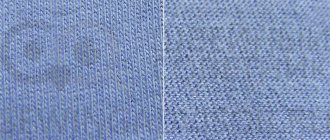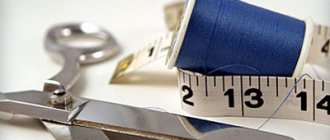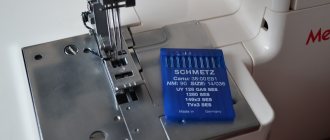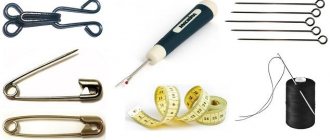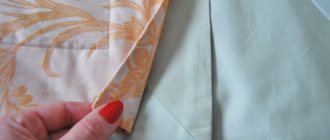The twin needle can be installed in any sewing machine that performs zigzag stitching. The main thing you should pay attention to before buying a double needle is the width of the hole (slot) of the needle plate and the distance between the needles.
How to sew, and how to use a double needle, how to thread two needles at the same time? The threads are threaded in the same way as with one needle, only instead of one spool, two will be used. And both threads will go through the same upper thread tensioner.
In this video you will clearly see how to make decorative double stitches using a double needle, as well as how to hem knitwear using a double needle and sew braid to knitted fabric.
Using a twin needle increases the capabilities of your machine and makes finishing double stitches easier. In addition, when sewing knitwear, you can imitate the stitching of a flat-stitch machine. But most often, a double needle is indispensable when sewing clothes that have double stitching. Decorative finishing stitches on jeans, patch pockets, details of men's shirts, etc. You can stitch evenly and neatly by making just one seam with a double needle.
How do twin needles work?
Structurally, a double needle consists of the following elements:
- Two standard sewing needles designed for stitching on a household machine.
- Holder housing. Most often it is made of plastic. This element holds the double needles together into a single structure.
- Flask. Designed for installing double needles into the needle holder of a sewing machine.
The double needle can be used in any sewing machine with a zigzag function. In their foot and needle plate there is an oblong slot necessary for the free movement of two needles.
Purpose
There is a persistent misconception that you need to sew with a double needle on a sewing machine only in cases where you need to get two parallel lines. In fact, the “possibilities” of a dual device are much wider. It is used when necessary:
- Hem the sleeve or bottom of the jersey;
- Place a decorative stitch;
- Make a hemstitch;
- Sew on the braid;
- Form raised tucks.
To sew on the braid and form tucks, you will need to additionally purchase special feet.
Note. Such stitches are intended for decorating and hemming the bottom of products, and not for sewing individual parts.
Types of double needles
There are several types of needles:
- Universal. Used to work with natural and artificial threads. They are suitable for most types of fabrics. Often, universal double needles of this type are called embroidery needles, since they give a beautiful and even zigzag stitch.
- For knitted fabrics. These needles are marked Stretch. They can also be used for working with elastic and stretchy fabrics.
- Metallic. These twin needles are used for stitching with metallic threads.
- Jeans These needles are used for stitching denim fabrics. As a rule, these are thick needles that are intended for working with high-density fabrics.
Double needle stitching of different widths is possible. The thinnest needles have a thickness of 1.6 mm. The maximum value is 4 mm.
The largest number of sizes are represented by universal double needles. The thinnest are considered to be products for stitching on elastic fabrics (number 75). Denim options include sizes from 100 and more.
The double needle is marked with two numbers. It is deciphered as follows:
- The first number indicates the distance between the needles.
- The second talks about the size of the needles (they must be of the same section).
Technical features
The specifics of installing and using a twin needle are the same for all brands, including Janome, Brother and Jaguar: two threads on two bobbins are threaded into two needles, securely fixed to the presser foot.
Popular models that are most often purchased with an eye toward working with 2-needle systems:
- Classic "The Seagull".
- Minerva B21 with several types of elastic stitches and automatic buttonhole processing at all stages of sewing.
- All-metal Janome LE 22/L-394, capable of real-time sewing with threads of different thicknesses.
- Brother M-14 with a horizontal shuttle and record low noise levels.
Other models on the market either do not have the same successful design solutions or are unreasonably expensive.
Inserting the needle into the sewing machine
To install a twin needle in a sewing machine, you must follow these steps:
- Using the flywheel, set the needle holder to its highest position.
- Lower the machine foot.
- Loosen the fixing screw. In this case, you need to hold the installed needle. Now carefully loosen the fixing screw. Next, remove the needle from the holder.
- We install the double needle in the holder so that the flat part of the flask faces backwards. We deepen the needle until the edge of the flask touches the stop.
- While holding the twin needle in position, tighten the fixing screw. All that remains is to thread the thread, and you can give a test stitch.
We have prepared for you a detailed video course “Sewing Basics”
Get it now for free!
get a course
Installation
The installation of such a device is no different technically from the placement of a traditional needle. It is worth remembering that the cut should be located at the back, and the round side should be facing the seamstress. It is best if each coil has a separate holder, but if this is not the case, then you can do as shown in the image.
When threading, the actions are no different from regular sewing. Simply, when passing through each hole and thread guide holder, you should do this for two threads at once. But you will need to separate the threads before the last thread guides, and then thread them into the eyes of the double device. Some models have only one lower thread guide. In this case, the left thread is passed through it, and the right one goes next to it and is threaded directly into the eye.
When working, you should monitor the position of the sewing mode switch. A double needle is used exclusively in straight stitch mode. If you install a seam with an offset, for example, a zigzag, the needle will simply break on the plate.
It is best to place the spools of thread in such a way that one unwinds clockwise, and the other counterclockwise. This will protect the threads from tangling while working. Using the minimum speed will also prevent them from getting confused.
Threading the machine
To double stitch, you need to thread two threads into both needles. Accordingly, you will need a couple of coils. To obtain a neat seam, it is necessary to thread threads of identical thickness and quality into a double needle. You can choose any color, it all depends on your design ideas (this will not affect the quality of the stitching).
Threads into a double needle are threaded according to standard rules. The specifics of the procedure depend on the design of the specific machine. But all models are equipped with the following elements:
- thread tensioners;
- guides;
- thread guides, etc.
Therefore, to thread a double needle, you should use the instructions supplied with your specific sewing machine. Both threads are carried along the tensioners together, separating only at the very end, at the stage of threading through the eye of the needle. Threading the shuttle remains unchanged.
After completing the work, you will need to give a test line. It will help you make sure that everything was done correctly, and then you can sew with a double needle.
What should I do if my twin needle skips stitches when sewing?
It is not always possible to get a high-quality seam with a double needle the first time. If skipping stitches are noticed while sewing, do the following:
- We wind the upper threads onto spools of equal size. This approach will allow you to achieve uniform tension on each thread when sewing with double needles. The coils are arranged on one spool pin.
- Try increasing the upper thread tension. This should also be done if the stitches were uneven and the thread looped. Make sure both threads have the same tension and are threaded correctly into the needles. The bobbin thread tension should be standard.
- Check that the threads are threaded correctly when sewing with a twin needle.
What types of needles are there?
The range of double needles is so extensive that it can be difficult for a person inexperienced in tailoring subtleties to make a choice. Therefore, before you make a purchase and start sewing correctly with a double needle, you should understand what the differences are.
First of all, you need to decide what type of canvas you plan to work with. Manufacturers produce fabric needles:
- Stretch;
- Jeans;
- Regular (non-elastic) “Universal”.
You should not use the same needle for working with different types of fabric. Despite the apparent similarity in appearance, they have different angles of sharpening the tip, arrangement of the eye and groove.
Depending on the thickness of the material, the needle number is selected. For:
- light (thin) – No. 70, No. 75;
- medium - No. 80;
- dense, thick (jeans) - No. 90, No. 100.
Attempts to sew with a double needle of the wrong number will result in skipped stitches and broken threads.
The next criterion is the distance between the needle points. In the marking it is indicated after the number, through a fractional line (solidus). Depending on the type of needle, it can vary from 1.6 to 6 mm.
Needles with an inter-needle distance of 6 mm are suitable for household machines with a stitch height of 7 mm. If the functionality of your “assistant” is limited to 5 mm, then the maximum allowable parameter will be 4 mm.
To make sure the needle fits:
- Remove the foot.
- Insert the needle.
- Slowly turn the handwheel to lower the needle to the lowest position.
- If it fits smoothly into the hole, you can start sewing with a double needle on a machine.
The nuances of working with a double needle
To obtain an even and high-quality seam, the correct selection is necessary:
- threads;
- fabrics;
- needle
We are talking about the thickness of the needle and thread, as well as the type of material. It is very important to correctly select these parameters relative to each other. To achieve a beautiful and even stitch, working with a double needle is carried out at a reduced speed of the sewing machine.
Double needles can be used to stitch, embroider, quilt, etc. Such stitches are often used as decorative finishing on the bottom and side cuts and seams of products. They are especially popular when working with denim. It turns out to be almost impossible to make such a seam with only one needle, since it is difficult to maintain not only the same distance between the lines, but also the symmetry of the stitches.
As a rule, such stitches are performed as follows: we place the first needle at a distance of 1 mm from the edge of the product. These seams are not only reliable, but also have high decorative properties. If desired, you can use threads of different colors when working with double needles.
Safety precautions during operation
Sewing on a machine requires compliance with certain rules. This work only seems safe, but in reality it is quite easy to get injured.
For example, a prerequisite for the first sewing with a double needle is familiarity with the instructions. You need to read the operating instructions for the machine (if there are any) and study the information indicated on the packaging with the needles (as a rule, you can always find technical specifications there).
There are other, no less important rules:
- Always count how many needles you have taken out of the package before you begin. If at the end of sewing there are fewer of them, then you need to carefully examine the space next to you. Perhaps a few pieces fell accidentally.
- Hide packages of needles from children, even if you have not opened them yet.
- Do not use broken tools. If the needle is damaged and there is no new one, it is better to postpone sewing. Otherwise, there is a high risk of not only ruining the product, but also breaking the machine or getting hurt.
LiveInternetLiveInternet
Any sewing machine sews with a double needle - this is not a function of the machine itself, but of the needle that you insert. You need to thread 2 spools of thread on top, then insert the threads into 2 eyes of the needle and sew. Since there is 1 bobbin at the bottom, the bottom line looks zigzag, and the top line looks like 2 parallel lines. It turns out beautifully when the tension of the upper threads is slightly tightened, then the seam on the knitwear turns out to be convex. When you get the hang of it, try threading two different colors of thread up and making a decorative stitch with a double needle, it’s very beautiful! Just be careful at the beginning, some machines make such a mistake that the width of the decorative stitch goes the entire width of the foot and the second tail of the needle risks hitting the foot.
But! I would like to note that any machine can use double needles if the thread is inserted into the needle from the front. And now, I suggest you familiarize yourself with useful information on this topic, taken from various sources
The twin needle can be installed in any sewing machine that has a zigzag stitch. The main thing to pay attention to before buying a twin needle is the width of the needle plate hole. The distance between the needles should not be wider than this hole. How to sew and how to use a double needle? Just like you use one needle, only with two top threads, passing both threads through one tensioner. Twin needle sewing increases the capabilities of your machine and makes decorative and finishing stitches easier. Using a double needle for knitwear makes it possible to imitate the stitching of a flat-stitch machine. A sewing double needle is indispensable when sewing clothes with double stitching. Finishing stitches on jeans, patch pockets, details on men's shirts, etc. You can stitch evenly and neatly by sewing a seam with a double needle.
How to use a double needle
How to use a double needle? Just like with a regular needle, you just need to buy a suitable double needle for your sewing machine model and thread both upper threads simultaneously into two needles. The bottom thread in the bobbin will be used by both top threads at the same time.
Twin needles are not suitable for all machines.
Double needles can sew different fabrics, but only in machines with a zigzag stitch; straight-stitch machines like Podolskaya are not intended for their use. The needle plate of these machines has one round hole, while the double needle requires a narrow and wide slot, which is used in zigzag stitch machines. In addition, additional thread guides and a stand for the second spool are required. If you are going to install a twin needle on your Chaika sewing machine, pay attention to how the needle is positioned in the hole when it is sewing a straight stitch. The needle should pass exactly in the center of the needle hole. If there is misalignment when using a double needle, it may break.
An additional creel is required for the second spool of thread.
Modern sewing machines Janome, Brother, Juki and many others have a creel for two spools of thread and paired thread feeders and thread guides, into which the upper threads are threaded separately.
Double needle installation
A double needle fits into any sewing machine, just like a regular needle. The flat of the needle (cut) should be directed back, away from you, and the round side should be directed towards you, forward. Each coil must have a separate pin (coil holder), sometimes an additional one is installed for this. If there is only one spool stand on the machine body, then a second one is included in the kit. The threads from the spools are passed through all the thread guides, including the upper thread tensioner, together, and only the lowest thread guides separate them into needles. The left thread is threaded into the left needle, the right thread into the right needle. If there is only one thread guide, like Chaika’s, then the left thread is passed through the thread guide, and the right one next to it, directly into the eye of the right needle.
What are they and their purpose
A double needle can have different distances between the needles - narrower, wider, and there are even triple needles. Different widths make it possible to choose the width of the finishing stitch and use it for design. The use of double needles is more intended for decorative seams that do not experience heavy loads. Of course, it can be used to make finishing stitches on a pocket or flap shirt. But, we should not forget that to form a seam, a double needle uses only one thread - the bottom one, so such a seam will not be particularly strong. But, for example, for embroidering two or three parallel patterns at the same time, a double needle is simply irreplaceable. This pattern looks especially impressive if the threads are of different colors. Using double needles with a narrow gap between them, you can create an imitation of shadow in the design. Using narrow needles, I place threads on top of each other, creating a shadow effect. In addition to simple finishing stitches, double needles can be used for sewing on braid, performing elastic gathering, tucks and other operations.
Attention! Incorrectly selected double needles may break
When buying double needles in a store for your sewing machine, pay attention to the maximum width of the needle plate opening on your machine, or simply the width of the zigzag stitch on your machine. Incorrectly selected needles may break, hitting the needle plate. In addition, before you start sewing with a double needle, watch the stitch type switch. The stitch should not be set to a zigzag or other needle offset, such as zipper stitching, etc. The double needle should only work in straight stitch mode. In any other mode, they will simply break on the needle plate of the sewing machine.
Use of double needles
Have you used twin needles on your sewing machine yet? Now you will find out how many decorative and other possibilities its use in creating clothes provides.
To use double needles you need:
front threading
the presence of a zigzag stitch in a sewing machine.
the distance between the needles should not exceed the maximum zigzag width of your machine!
Preparatory operations.
Install a double needle on your machine, just like a regular single needle.
If your machine has two spool holders, install the spools so that one spool thread unwinds clockwise and the other counterclockwise. This will prevent the threads from getting tangled when sewing.
Next, both threads are threaded along the thread guides in the same way, both threads go side by side and only before threading into the needles do the threads diverge along different guides: one thread on the left, the other on the right.
If you don't have two thread guides, insert one thread into the thread guide and leave the other loose.
Thread the threads into the corresponding needles. The machine is ready to sew. I advise you to sew at minimum speed, this will also help prevent threads from tangling.
Decorative stitches (embroidery) Does your machine have decorative stitches? Try using twin needles to embellish clothing with these stitches.
The double needle allows you to embroider two parallel designs at the same time. You can thread the upper threads in different colors.
If you use narrow needles 1.8 - 2.5 mm, the stitch patterns will overlap each other, creating a shadow effect.
For decorative stitches, use a needle size smaller than the maximum zigzag width on your machine!
Sew on the braid
Place a needle slightly smaller than the width of the braid into the needle holder and attach the satin stitch foot to the machine. This foot has a wide groove on the sole.
Set the machine controls to straight stitch and desired stitch length. Loosen the upper thread tension. Thread the ribbon through the needle hole of the foot (or under the foot).
Place the fabric under the foot, lower the needles into the fabric and sew. The braid is attached to the fabric on both sides at the same time.
Ruffles with elastic
Wind a thin sewing elastic band (like Hungarian) onto the bobbin. The upper threads must match the fabric and match the color.
Set the stitch length to 2-2.5 mm and sew with a straight stitch.
An elastic band tucked into the shuttle mechanism will create uniform gathers on thin fabric. Admire how the use of a similar technique decorated the blouse.
Embossed pintucks on fabric For the following embellishments, you will need a special foot for raised pintucks. The foot has grooves on the sole into which the fabric is pulled during sewing, resulting in a raised fold.
Different pleat sizes require different presser feet. The wider and deeper the grooves, the more voluminous the relief can be obtained. Many parallel grooves on the foot allow you to lay reliefs that are even relative to each other.
The foot with 7 grooves is designed for small pintucks and is used on light fabrics.
A foot with 5 deep grooves is used for sewing on medium fabrics and allows you to make larger pintucks. This foot can also be used for sewing in cord.
To make reliefs on light fabrics, it is recommended to use needles with a width of 1.6 - 2 mm; on medium tissues, needles 2.5 - 3 mm; and needles 4 mm or more on medium and heavy fabrics.
When stitching pintucks, the upper thread tension regulator should be set to 7-9, that is, to the maximum.
When decorating fabric with reliefs, keep in mind that the consumption will be higher.
It is very important to perform the first tuck exactly, since the evenness of subsequent ones will depend on this. Therefore, draw the first line on the fabric and only then place a tuck along it.
It is advisable to first make reliefs on the larger part, then apply the pattern over the part and mark the cut lines.
For wide stitching of reliefs, use a quilting guide.
Reliefs can be both decorative and serve as darts.
See how you can decorate a summer blouse with raised tucks. Use embossed pintucks to decorate underwear, children's clothing, blouses, and summer tops.
Reliefs on fleece
How much time do you spend knitting a sweater? Try knitting a sweater in one day using a double needle. Believe me, it's very simple and fast!
For such reliefs as in the photo, you will need fleece and a double needle of at least 5 mm. Such reliefs will look beautiful on velvet.
Reliefs with cord
To sew in the cord, use a double needle of such a width (the distance between the needles) that the cord passes freely between the needles.
Install any foot suitable for sewing in cord: a foot for sewing on beads or a foot for large embossed tucks.
Using a chalk or disappearing marker, draw a straight or curly line on the fabric where you want to add cord trim.
Pin the end of the cord to the beginning of the line on the wrong side of the fabric.
Place the fabric with the cord under the foot, make sure that the cord fits exactly between the needles and start sewing with a straight stitch following the line drawn on the fabric.
This is what the “reliefs with cord” trim on a blouse looks like. And these figured reliefs are made on transparent fabric with a backing of cords in a contrasting color.
Sewing knitwear
To sew knitwear, use special needles for sewing knitwear with a width of 4-5 mm.
In the photo, the hem was made with a 4 mm needle. On the front side you can see a double straight stitch, on the reverse side there is a “zigzag” stitch, which allows the knitted fabric to stretch. This stitch imitates sewing on an overlocker.
Set your machine to the straight stitch and desired stitch length.
Fold the edge of the knitted product, lay a stitch along the front side at the same distance from the fold.
Carefully trim the seam allowance close to the zigzag.
Sample stitches using a double needle were made on a Janome sewing machine model My Excel 23X. This machine has a maximum zigzag width of 6.5 mm.
ADELERA
